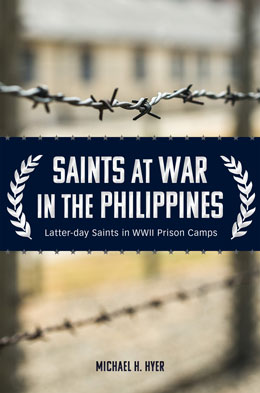You’re in the Army Now
Michael Harold Hyer, “You're in the Army Now,” in Saints at War in the Philippines: Latter-day Saints in WWII Prison Camps (Provo, UT: Religious Studies Center, Brigham Young University; Salt Lake City: Deseret Book), 5‒20.
Oh, thus be it ever, when free men shall stand,
Between their loved homes and the war’s desolation!
—Francis Scott Key, “The Star-Spangled Banner”
We often think of World War II beginning for the United States on December 7, 1941, with the Japanese attack on Pearl Harbor. But for many young men in America, the key life-altering event occurred more than a year earlier with the passage in September 1940 of the Selective Service Act—in other words, the draft. Enlistment was often preferable to being drafted, and at that time it was generally believed you could enlist and be out in one year.[1]
Most of the Latter-day Saint soldiers in this story were drafted into the army or joined to avoid the draft. There were, however, some exceptions. For example, James Patterson of Sunnyside, Utah, who seemed destined to a life as a coal miner in Price, Utah, joined the army looking for something better.[2] Carl D. Rohlfing of Salt Lake City, Utah, had been working the graveyard shift for the D&RGW Railroad at the Salt Lake Depot when, in October 1940, he decided to enlist in the army for one year, both to avoid the coming draft and, ironically, because he did not think his current job was good for his health.[3] While a poor, struggling college student, Robert Davey joined the Army Reserve Officer Corps because it provided a free uniform and additional physical education credits.[4]
The 200th Coast Artillery Regiment
On December 19, 1940, George Robin (Bobby) Brown, along with John A. (Jack) Keeler, his lifelong buddy and a fellow Latter-day Saint, enlisted in the 200th Coast Artillery Regiment of the New Mexico National Guard in Deming, New Mexico, as the preferred option to the draft.[5] Bobby was twenty-five years old at the time; the oldest son, he was the second oldest of six children of the George and Ruby Brown family in El Paso, Texas.
Bobby was born on August 16, 1915, at the home of Ruby’s mother, an experienced midwife, in Colonia Juárez, Chihuahua, Mexico. Shortly before George was to give the child a name and a blessing at a sacrament meeting, George’s father handed him a note saying, “It would please me greatly if you would name the baby George Vernon.” George ignored the request, held the baby in his hands, and gave him a blessing and the name “George Robin Brown”—George for the child’s father and Robin for his mother. “Robin” was Ruby’s nickname, given her when she was a young woman growing up in Mexico by some local cowboys, a group that had included George. She was presumably nicknamed after the pretty, but always very busy, bird. The family came to know George Robin Brown as Bobby.
Bobby spent his boyhood growing up on his family’s cattle ranch in Chuichupa, a remote mountain Latter-day Saint colony in Chihuahua, Mexico. About ten years before his enlistment, the family left the ranch life in Mexico and moved to El Paso for better educational opportunities for the children. Like most other families at the time, the Browns had been struggling to make it through the Great Depression.
Like Brown, Keeler was also born in Colonia Juárez. At the time of his enlistment, he was living in Deming, New Mexico, and was a close friend of Bobby and his family.[6] That same month the two young men enlisted, their unit was “inducted into federal service” (activated), meaning it was now part of the United States Army.[7]
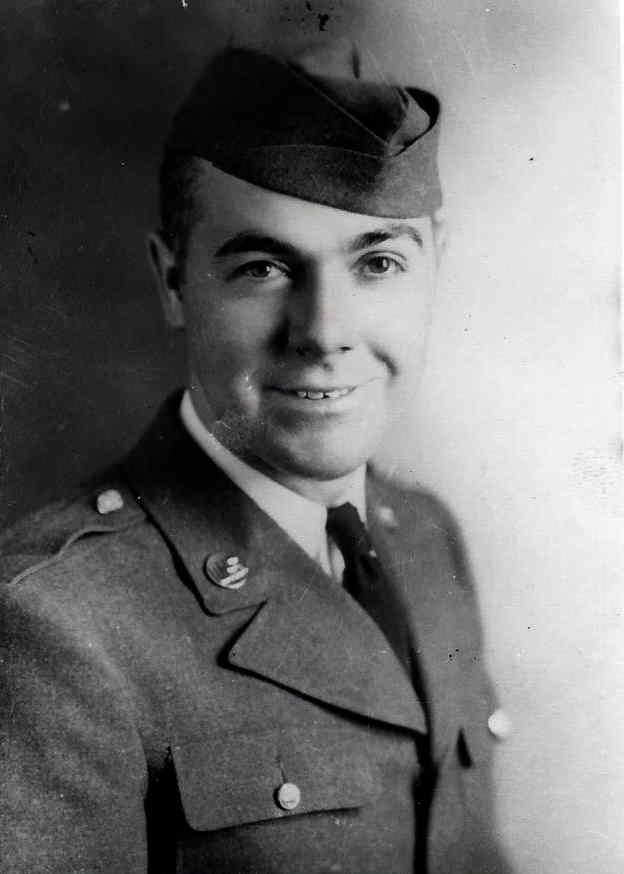 George Robin Brown, United States Army, December 1940. Courtesy of Brown family collection.
George Robin Brown, United States Army, December 1940. Courtesy of Brown family collection.
Two months later, on February 21, 1941, Orland K. Hamblin from Farmington, New Mexico, was drafted into the army in Santa Fe, New Mexico, and sent to the 200th Regiment of the New Mexico National Guard, followed by training in El Paso.[8] Hamblin was twenty-three years old at the time; before being drafted, he had served in the Texas-Louisiana Mission of the Church.
Shortly after arriving at Fort Bliss, Hamblin found the El Paso Ward, the local Church congregation. An active participant, he became acquainted with the Brown family, also active members of that congregation.[9] Hamblin recruited one of his four tentmates, a soldier from Texas who was not a member of the Church, to attend church meetings and socials with him, earning them the title of “Sunday School Boys” from their commanding sergeant. Hamblin joined the choir and spoke in meetings. Of these experiences, Hamblin wrote years later that the “good people of the El Paso Ward did much to make my stay in Fort Bliss, and army life, bearable,” and these experiences were among the “bright spots” he would remember in the following not-so-pleasant years.[10] There were two other Latter-day Saint servicemen in the 200th: William Murle Allred from Artesia, Arizona, who enlisted in March 1941, and Don Charles Bloomfield from Ramah, New Mexico, who enlisted in April 1941. They also may have become acquainted with Hamblin, Brown, and other Church members in El Paso.[11]
Among those with whom Brown also became acquainted in the 200th was Arthur M. Baclawski. A native Ohioan, Baclawski had graduated as a landscape architect from the Ohio State University and was recruited by the Civilian Conservation Corps (CCC)—one of President Franklin D. Roosevelt’s “New Deal” natural resource conversation programs—to do landscape architectural planning for various projects in New Mexico. While working for the CCC, he was drafted into the New Mexico National Guard.[12] Baclawski was not a member of the Church, but he and Brown shared a tent and became friends.
The 200th was an old cavalry unit that been consolidated with other units and, reflecting the changing nature of war, converted to the 200th Coast Artillery Regiment with a mission to defend coastal areas from air attacks.[13] It consisted of about nineteen hundred soldiers and its makeup reflected the local population—Anglo-Saxons (like Brown and Hamblin), Mexicans, Navajos, Apaches, and other Native Americans.[14] They trained in the desert around Fort Bliss, just north of El Paso.
Their training centered on firing the army’s three-inch and thirty-seven-millimeter antiaircraft guns and fifty-caliber machine guns, as well as operating sixty-inch Sperry searchlights. The guns were old, obsolete, WWI-era equipment. Also, because of a shortage of ammunition, the men were rarely able to fire live rounds. In addition to this artillery training, they received other typical military training, such as marching, close-order drills, and ten-mile hikes in the Texas sun.[15]
Before his enlistment, Brown had been working for El Paso Electric Company in a warehouse, and with that experience he was soon rated as a clerk and placed in headquarters supply. By January 5, 1941, Brown was a private first class and was quickly promoted to a sergeant on March 17, 1941; to a first sergeant on June 18, 1941; and finally to a master sergeant on July 15, 1941, placing him in charge of supplies for the unit.[16] This rapid promotion from a raw recruit in December to a master sergeant by the following July may not have been unusual at this time for the rapidly expanding army. Nevertheless, it is evidence that the army quickly identified Brown as a responsible individual with leadership skills.
Army officials toured the nation to assess the readiness and proficiency of every antiaircraft unit in the country and concluded that the 200th was “the best antiaircraft regiment (regular [army] or otherwise), now available to the United States Armed Forces.” For that reason, it was selected for “an overseas assignment of great importance,” although the location was not disclosed.[17] The next-ranking unit received the consolation prize—an assignment to Alaska.[18]
In early August 1941, the 200th received orders to prepare to ship out; again, the destination was not disclosed.[19] The local El Paso newspaper carried a nice article about Brown leaving with the 200th for an unknown destination. When asked about being shipped out by the army, Brown, reflecting the practical sense of duty characteristic of this generation of soldiers, simply told the reporter, “This is a job that has to be done, and I am pitching in and doing it.” Brown also received a letter from the president of El Paso Electric Company to the effect that a job would be waiting for him when he returned.[20]
Before shipping out, the 200th toured the major towns in New Mexico, parading before thousands who lined the streets to wish them well. Consisting of a 268-truck convoy stretching for miles, the 200th must have been quite a show.[21] Later, with the regimental band playing “O Fair New Mexico,” the soldiers of the 200th—including Brown, Keeler, Hamblin, and Baclawski—boarded railcar coaches chalked with V for Victory and left Fort Bliss for San Francisco by way of Los Angeles.[22]
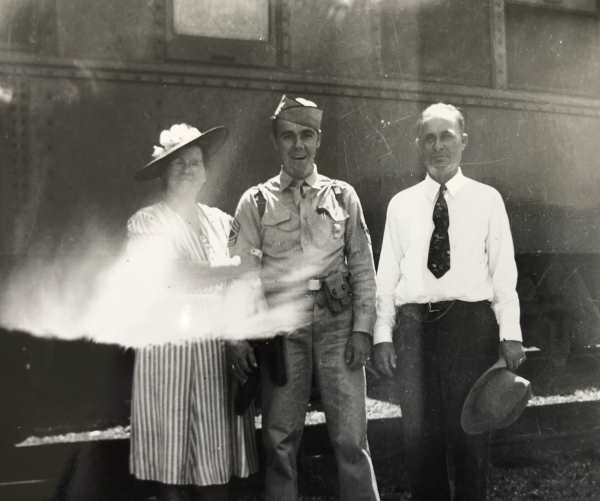 Master Sergeant George Robin (Bobby) Brown with his parents, George and Ruby Brown, before boarding the train for San Francisco, California, August 1941. Courtesy of Brown family collection.
Master Sergeant George Robin (Bobby) Brown with his parents, George and Ruby Brown, before boarding the train for San Francisco, California, August 1941. Courtesy of Brown family collection.
The broad smiles in the pictures notwithstanding, this was an emotional parting. Brown’s mother gave him a set of scriptures—a triple combination consisting of the Book of Mormon, Doctrine and Covenants, and Pearl of Great Price—and the Church youth group had given him a hymnbook. Just before his departure, Brown also received a special blessing from Church patriarch Harry L. Payne. The blessing included a promise for him “to be preserved to complete a mission on this earth.”[23]
Upon arrival at Fort Mason in San Francisco, the soldiers of the 200th were put on a barge to Fort MacDowell on Angel Island in the San Francisco Bay. At Fort MacDowell, the soldiers received one last physical examination and some vaccinations.[24]
There were a lot of enticing reasons for a young soldier to want to take a ferry over to San Francisco for an evening, and on Brown’s last night at Fort MacDowell, he did just that. It was a Sunday, and Brown went to attend church services in San Francisco. He stayed on to attend a Church fireside later that evening.[25]
The next day, September 8, 1941, Brown and others boarded the SS President Coolidge, an ocean liner requisitioned by the government for military transport. Passing under the Golden Gate Bridge at sunset, they set out into the Pacific for a six-thousand-mile voyage to a destination still unknown to the soldiers.[26] At the time of this voyage, the President Coolidge had not yet been refitted for military transport purposes and was still fitted out as a luxury ocean liner. Although the soldiers were crammed tightly together in the ship’s compartments, the voyage was an enjoyable experience for most. The soldiers did not have many duties on the voyage and had time to enjoy pretty sunrises and sunsets, an occasional whale sighting, and other pleasant aspects of an ocean voyage across the Pacific.
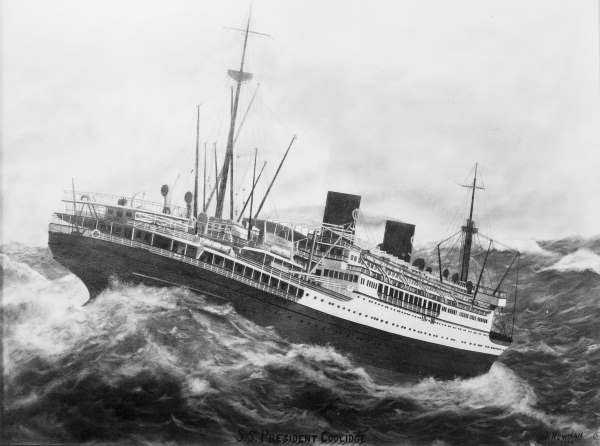 The SS President Coolidge, an American luxury ocean liner used to transport troops to the Philippines. By J.F. Newman. Public domain.
The SS President Coolidge, an American luxury ocean liner used to transport troops to the Philippines. By J.F. Newman. Public domain.
There was a good chance, however, that some of these soldiers did not especially enjoy the voyage. Unaccustomed to travel on high seas, many were seasick and spent most of their time heaving over the rail, a misery likely aggravated by the high winds and huge waves from a typhoon they may have encountered.[27] All in all, however, the ship’s accommodations were comparatively good and the voyage generally pleasant. While they could not have known it at the time, they would later endure other ocean voyages in very different circumstances and conditions.
They stopped in Hawaii for a few days and then sailed out into the Pacific. At that point, the voyage took on a more serious nature as they sailed under blackout conditions. Five days after leaving Hawaii, they were finally told their destination, their assignment of great importance: the Philippines.
The Army Air Corp, Fifth Air Base Squadron
The 200th Coastal Artillery Regiment was only one of many units being mobilized and sent to the Philippines. Among the others was the Fifth Air Base Squadron of the Army Air Corps, based in Fort Douglas, Salt Lake City. This group was responsible for aircraft maintenance and the construction and maintenance of airfields. The Fifth Air Base Squadron left Salt Lake City on October 21, 1941, aboard a troop train for San Francisco. They arrived on October 23, 1941; following the same route as previous soldiers, they were transferred to Fort MacDowell on Angel Island, where they remained for a few days for final physical examinations and processing. On October 27, 1941, the group departed San Francisco aboard the USS Hugh L. Scott for a destination that also had not yet been disclosed to them.[28]
Among those in the Fifth Air Base Squadron aboard the USS Hugh L. Scott were more than twenty Latter-day Saint soldiers.[29] Similar to the experience of those on the SS President Coolidge a month earlier, the voyage was generally pleasant. But they were crowded and some, such as Private Franklin T. East, a Latter-day Saint soldier from Arizona, suffered miserably from seasickness.[30]
Among the airmen in the Fifth Air Base Squadron was Staff Sergeant Ernest R. Parry from Salt Lake City. His father had died in 1935, when he was only thirteen and, as the only son and brother to two sisters, he had a special concern for his widowed mother and sisters. Nevertheless, after high school and with the draft looming, Parry enlisted in the army. Before he left Salt Lake with his squadron, Parry received a patriarchal blessing promising that he would “grow strong in the face of trial and temptation, growing strong in resisting temptation and thereby becoming an example of righteousness.” He was also admonished to “be humble and prayerful before the Lord and He will never desert you, for the promise given to the faithful shall be yours, that your yoke shall be made easy and your burden light.”[31]
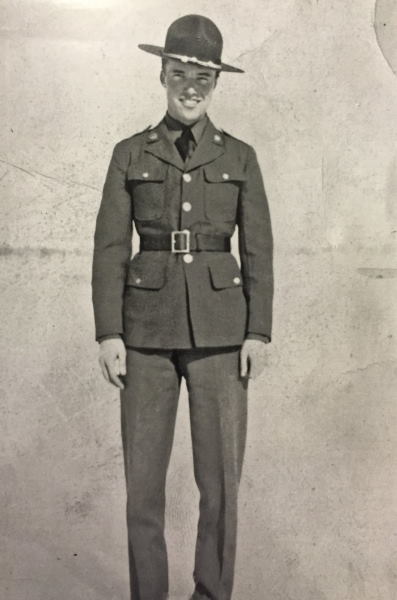 Staff Sergeant Ernest R. Parry, Fifth Air Base Group, United States Army Air Corps, 1941. Courtesy of the Parry family.
Staff Sergeant Ernest R. Parry, Fifth Air Base Group, United States Army Air Corps, 1941. Courtesy of the Parry family.
The Fifth Air Base also stopped for a few days in Honolulu, Hawaii. For some this stay in Honolulu produced some important, and perhaps unexpected, memories. Private East had married Ione Louise Hatch in the Salt Lake Temple on October 1, 1941, just three weeks before his unit left for San Francisco. In addition to being miserable from constant seasickness, he was also missing his new bride and was apprehensive about the future. He was, in his words, “seasick, homesick and everything else.”[32]
Staff Sergeant Ernest Parry came to his aid. They attended Sunday services. It was a special experience, and in a letter home, Parry wrote that he wished the Spirit he felt there could always be with him.[33] With Parry’s encouragement, Parry and East also toured the island, went to the Church’s mission home in Honolulu, and visited the Church’s Laie Hawaii Temple. It was a happy and memorable experience. It was also one that East, in the years and hardships that followed, thought about and in which he found encouragement. Years later when East wrote of his experiences in the war, he wrote in some detail of this time with Parry in Honolulu, concluding, “I was grateful to have a friend like [Parry and] thankful to the Lord that I knew him and what he had done for me.”[34]
East and Parry weren’t the only ones to have memorable experiences in Hawaii. While waiting in Hawaii, Staff Sergeant Nels Hansen, a Latter-day Saint soldier from Weiser, Idaho, had his first encounter with the Japanese. He attended a Latter-day Saint Sunday School consisting of about fifteen people, mostly children, all Japanese. While only a brief experience, the sincerity and knowledge of the gospel of these Japanese Saints made a deep impression on Hansen—an impression that, despite all that he would later suffer at the hands of the Japanese, he never forgot nor revised.[35]
On November 6 the unit left Hawaii in a convoy. The following Sunday, sailing out in the blue Pacific Ocean, Parry and East organized the first meeting of the Latter-day Saint servicemen aboard the ship. Major Ray Elsmore, a member of the Church and commander of the Fifth Air Base group, and Staff Sergeant Nels Hansen were the speakers. Around thirty or so servicemen attended, and it was, according to East, a “very good meeting.” At that meeting, they organized themselves, and Hansen was chosen as the group leader. That was the beginning of regular religious services among those servicemen.[36]
United States Army Infantry
For Robert (Bob) Davey, the events leading to his voyage to the Philippines were different. Davey’s father had owned a successful furniture business in Salt Lake City, and Davey grew up in relatively prosperous circumstances in a close and happy family. However, his mother died in 1933 from a prolonged illness, and Davey was deeply affected by her death. Although his father later remarried, the family was never quite the same.
With the Great Depression, the family’s furniture business failed. Although Davey once may have looked forward to a substantial inheritance, there was now nothing left. Nevertheless, he enrolled in the University of Utah and, with borrowed money and by working several jobs, managed to graduate with a Bachelor of Science degree in business administration in 1938. During the time he was a student, a friend suggested he join the Army Reserve Officer Corps because it provided a free uniform and additional physical education credits. Davey joined and earned a commission as a second lieutenant in the United States Army.
With the mobilization of forces in anticipation of war, Davey was called into active duty. While Davey was away training at Fort Ord in California, his father died of a heart attack. A month later, in October 1941, having lost both his mother and his father but still with a sister and brothers at home, Davey found himself in the San Francisco Bay aboard the USS Tasker H. Bliss, a former luxury liner, as part of the infantry departing for the Philippines. When first notified of the destination, Davey received it as good news. At that time, he had little fear of war in the Pacific; Hitler’s war in Europe was the concern. The tour to the Philippines was expected to be short; he expected he would soon be back home.[37]
In addition to their common religion and culture, these Latter-day Saint soldiers would now have this in common: With the voyage to the Philippines, they would all be caught up in a swift and powerful current of world events leading to war and, for them, imprisonment.[38]
Notes
[1] John C. Shively, Profiles in Survival: The Experiences of American POWs in the Philippines During World War II (Indianapolis: Indiana Historical Society Press, 2012) .
[2] James Patterson, “Saving the Legacy: An Oral History of Utah’s World War II Veterans,” interview by Luke Perry, August 15, 2001, Tape No. SL-283 & 284, Fort Douglas Museum and Marriott Library, Special Collections Department, University of Utah, Salt Lake City, 1.
[3] Carl Dennis Rohlfing, “Carl Dennis Rohlfing” (undated manuscript provided to the author by Dennis Autry), 1.
[4] Springgay, “Robert Gray Davey,” 13.
[5] National Guard of New Mexico, Enlistment Record of George Robin Brown, Serial Number 20,842,469, December 19, 1940, National Personnel Records Center, National Archives and Records Administration, 1 Archives Drive, St. Louis, MO 63138 (hereafter “NARA Records”).
[6] Lowell Eliason Call, “Latter-day Saint Servicemen in the Philippine Islands: A Historical Study of their Religious Activities and Influences Resulting in the Official Organization of The Church of Jesus Christ of Latter-day Saints in the Philippines,” All Theses and Dissertations, Paper 4579 (Brigham Young University, 1955), 107.
[7] Kenneth G. Wickham, Major General, United States Army, The Adjutant General, “Official Statement of Military Service and Death of George R. Brown, 0 890 150,” NARA Records.
[8] Orland K. Hamblin, “My Experience in the Service and as a Prisoner of War of the Japanese” (unpublished manuscript, June 1956), 1.
[9] See also Call, “Latter-day Saint Servicemen,” 115 (quoting August 14, 1954, letter from Peter Nelsen Hansen, referring to Hamblin as a close friend of Brown).
[10] Hamblin, “My Experience,” 1–2. Of Hamblin’s four tentmates, only Hamblin survived the war; the other three all died while POWs.
[11] The enlistment dates for Allred and Bloomfield are from army enlistment records, and Pacific POW rosters identify them as members of the 200th Coast Artillery. Bloomfield was an active member of the Church, having served a mission in the Northern States Mission before the war, and was likely involved with other Church members. See Freeman and Wright, Saints at War, 279–80. Little is known about Allred, although he appears to have come from an active Latter-day Saint family, as his parents were endowed and sealed in the temple.
[12] Arthur M. Baclawski, “Personal History” (unpublished manuscript in family records, copy provided to the author by Charles Baclawski).
[13] Shively, Profiles in Survival, 188.
[14] Dorothy Cave, Beyond Courage: One Regiment Against Japan, 1941–1945, 2006 ed. (Santa Fe, NM: Sunstone Press, 2006), 25–26.
[15] Cave, Beyond Courage, 24, 66–68; Shively, Profiles in Survival, 188–90.
[16] Brown and Zundel, “George Robin Brown . . . His Story,” 14; United States Army, “Service Record of George R. Brown, 20842464,” NARA Records.
[17] Shively, Profiles in Survival, 190; Hamblin, “My Experience,” 1.
[18] The other unit was the 206th Coast Artillery Regiment from Arkansas, which was deployed to the Aleutian Islands in Alaska.
[19] Shively, Profiles in Survival, 190.
[20] Included in Brown’s military file is a copy of a newspaper clipping dated August 24, 1941, that contains this quotation and refers to this letter. The name of the newspaper is not indicated. NARA Records.
[21] Shively, Profiles in Survival, 191; Cave, Beyond Courage, 35; Hamblin, “My Experience,” 1.
[22] The First Battalion, with Hamblin, left on August 22, 1941; the Second Battalion, with Brown, Keeler, and Baclawski, left on August 31, 1941. Cave, Beyond Courage, 37–38. An article in the El Paso Herald-Post, dated February 11, 1942 (page 2), indicates that Brown left Fort Bliss on August 31, 1941.
[23] Nelle B. Zundel, “George Robin (Bobby) Brown,” in Brown, Alma Platte Spilsbury, 298; Nelle B. Zundel, “Story of the Family of George Andrew and Ruby Vilate Spilsbury Brown,” unpublished manuscript prepared for Brown family reunion, June 1961, 5.
[24] Cave, Beyond Courage, 38; Hamblin, “My Experience,” 2. There was also a brawl between the largely Anglo regular army soldiers at Fort MacDowell and the predominately Native American and Mexican-American soldiers of the 200th. There is no indication that Brown or Hamblin were involved, but the event illustrates the racial tensions in the military and the nation at the time. See Cave, Beyond Courage, 38; Shively, Profiles in Survival, 192. Angel Island had been the “Ellis Island” of the West, where immigrants (largely Chinese) had passed through. At this time, however, it was the depot for processing soldiers who were shipping out overseas. The concrete remnants of buildings of the former Fort Mason still remain.
[25] Brown and Zundel, “George Robin Brown . . . His Story,” 14–15.
[26] Brown and Zundel, “George Robin Brown . . . His Story,” 14–15; Cave, Beyond Courage, 40–41. Hamblin and those in the First Battalion had left earlier on a different transport ship.
[27] Shively, Profiles in Survival, 192–94; Cave, Beyond Courage, 40–41; Hamblin, “My Experience,” 2–3.
[28] Allen C. Christensen, “My Life History” (unpublished manuscript, April 1961), 5. A copy of this personal history was provided to the author by Christensen’s grandson Cody Christensen.
[29] The author has identified the following Latter-day Saint air corpsmen in this Fifth Air Base group: Staff Sergeant Peter (Nels) Hansen from Weiser, Idaho; Private First Class Allen C. Christensen from Tremonton, Utah; Private First Class Charles L. Goodliffe from Park Valley, Utah; Staff Sergeant Ernest R. Parry from Salt Lake City, Utah; Private James Patterson from Sunnyside, Utah; Private Jack W. Bradley from Moroni, Utah; Private Mack K. Davis from Lehi, Utah; Private First Class Woodrow L. Dunkley from Franklin, Idaho; Second Lieutenant Richard E. Harris from Logan, Utah; Private First Class Ferrin C. Holjeson from Smithfield, Utah; Private Russell Seymore Jensen from Centerfield, Utah; Private First Class Lloyd Parry from Logan, Utah; Private First Class Ronald M. Landon from Kimball, Idaho; Private Harry O. Miller Jr. from Magrath, Alberta, Canada; Private First Class Lamar V. Polve from Kenilworth, Utah; Private Jesse G. Smurthwaite from Baker, Oregon; Private Frederick D. Thomas from St. Johns, Idaho; Private Franklin T. East from Pima, Arizona; Corporal Kenneth B. Larsen from Salt Lake City, Utah; Corporal Carl D. Rohlfing from Salt Lake City, Utah; Corporal Donald L. Vance from Fairview, Utah; and Corporal Raft T. Wilson from Alta, Wyoming. Major Raymond Elsmore, commander of the Fifth Air Base Group at Del Monte Airfield, was also a member of the Church. He survived the war but was never a POW. See note 36. This list is based on the author’s research and may not be complete, as there may have been other Latter-day Saint corpsmen in the Fifth Air Base group or in other units on that ship.
[30] Franklin T. East, “Army Life of Franklin T. East,” November–December 1977, 5, unpublished manuscript accessible at familysearch.org under Franklin Thomas East (KWCR-6W1).
[31] Suzanne Julian, “Led by the Spirit” (BYU devotional address, February 11, 2014), https://
[32] East, “Army Life,” 6.
[33] Crystal Grover, email message to author, April 30, 2017. (Grover is the granddaughter of Parry’s sister.)
[34] East, “Army Life,” 6. East spelled the name Perry, but from the context and other information it is evident he was referring to Ernest Parry.
[35] Ashton, “Spirit of Love,” 174–75.
[36] East, “Army Life,” 7 (estimating between fifteen and twenty present); Call, “Servicemen in the Philippine Islands,” 114 (Call quotes a letter where Hansen estimated that “nearly 40” were present). Elsmore left for Australia before the Philippines fell to the Japanese; in Australia, he was put in charge of military air transport operations in the Pacific. He survived the war and completed a distinguished postwar career in civilian aviation. Trans Ocean Airlines, History, 1946–1960, Airline Officials, http://
[37] Springgay, “Robert Gray Davey,” 13–14.
[38] Another sizable group of Latter-day Saint soldiers came to the Philippines earlier as part of the 20th Pursuit Squadron of the Army Air Corps, based at Nichols Field just south of Manila. Those Latter-day Saint soldiers included Gene Jacobsen, Harold Poole, and Clarence Bramley. They also became POWs when the Philippines fell, but their imprisonment took a different course than the POWs who are the principal subject of this book. For example, the POWs from the 20th Pursuit Squadron were never imprisoned at Dapecol. Nevertheless, the book refers to these three POWs in several instances to round out our understanding of the POW experience of Latter-day Saints. Their individual stories are well told respectively in Gene S. Jacobsen, We Refused to Die: My Time as a Prisoner of War in Bataan and Japan, 1942–1945 (Salt Lake City: University of Utah Press, 2004); James W. Parkinson and Lee Benson, Soldier Slaves (Annapolis, MD: Naval Institute Press, 2006); and William T. Garner, Unwavering Valor: A POW’s Account of the Bataan Death March (Springville, UT: Plain Sight Publishing, 2014).
